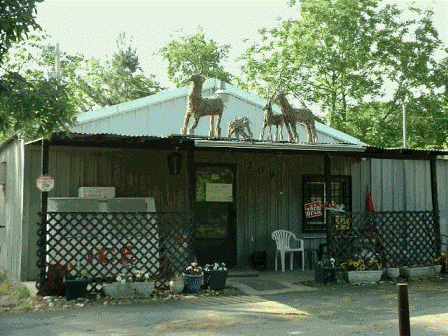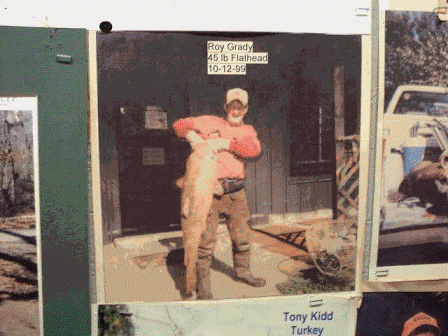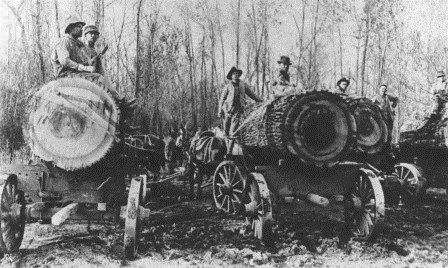
--Photo courtesy Gerald Torrence
The One-Stop Café in Georgetown is renown for the catfish it cooks from the river.
Oldest existing community in Arkansas
By HEBER TAYLOR
Arkansas Democrat-Gazette, October 3, 1999
G
eorgetown, a town of about 160 people in eastern White County, has a historical claim to fame: it’s the oldest existing community in Arkansas. Arkansas Post would be older if it were still around, but it was washed away by the Arkansas River long ago.
The first person to settle in the Georgetown area was a Frenchman named Francois Francure. He arrived in 1789 and lived on 1,361 acres of land, said to have been a grant from the Spanish government. He was there for 14 years before the territory became a part of the United States. It was ceded by France in 1803 as a part of the Louisiana Purchase.
The community was first called Negro Hill, possibly because Francure owned slaves or because it was a place for slaves headed for White County to be unloaded. Another possibility is that the large group of Negroes who were living on a hill by the White River in the community’s early days were slaves who had escaped from Louisiana plantations.
Another name for the community was Francure Township. It wasn’t until 1909 that Georgetown became the town’s name, chosen because three Clarendon men named George had bought land there in 1908, sold lots and helped the town to develop.
In 1908, the M&NA brought rail service to the town. It lasted until 1946. One of the trains had two cars and was called "The Moose." The old train station still survives as part of a private home, the Walker House.

The population in 1910 was 248. In 1909, a post office established in the area in 1870 was moved to Georgetown.
The White River has always been important to Georgetown. For many years, it was an important way to travel and to ship goods.
Polly Cleaver, one of the town’s historians, said that when she came to Georgetown in 1944, there were houseboats along the river as far as you could see. She has a picture of a houseboat with a stock pen attached, showing that people moved cattle and hogs up and down the river with their houseboats.
Fishing for catfish in the river was a good way to make a living. The late Marion Johnson was an excellent fisherman. Cleaver has a photograph of four catfish that Johnson caught in a net at one time. They weighed 92, 60, 50 and 44 pounds. Enough small fish were in the net to bring the total weight to 284 pounds, she said.
Georgetown is still known for its catfish, and its One-Stop Diner has the reputation of serving some of the best. A meal of catfish, french fries, hushpuppies, slaw, tea and dessert costs $5. A visitor needs to bring a good appetite because the diner staff feeds everyone well.
Earlier, the mussel shell industry was important. The shells are found on the bottom of the White River. Sand-colored ones were said to be the prettiest and most valuable, but round, black shells were also in demand. The shells were used to make buttons.
The late Pearl Johnson, who was born in 1901, told a reporter in 1985 that her father, Tom Akers, dug shells in the river with a hand rig. She said he found a pearl worth $40 in a shell. He sold the pearl and bought 80 acres of land with the $40. Johnson said she was named after that pearl.
In the same interview, she mentioned the log-rollings her family had when the timber was being cleared off the land. Men worked in pairs and used poles about eight feet long to put under and carry the logs, she said. About 10 or 12 men carried the logs.
While they worked, the women were cooking a huge meal. After working all day, "They would square dance all night," Johnson said.
Polly Cleaver has a photo of huge logs that timber men were hauling 85 years ago. A sawmill photo shows close to 30 workers, indicating timber’s important contribution to the economy.
Cleaver said that Georgetown used to have four stores, a hotel, a movie house, three fish docks, a handle mill that made ax and hammer handles, a mattress factory, a school, a drugstore, a barber shop, a doctor’s office, a dentist’s office, and two churches.
Cleaver’s husband, Sam, remembers that it cost 50 cents to have a tooth extracted in 1932.
Sam Cleaver also recalled one of the New Deal programs that helped the area to get through the Depression. "Cattle were sent here and allowed to roam in the woods," he said. "Then they were butchered and the beef was canned in canning kitchens and given away."
In its heyday, Georgetown’s population reached at least 350 and possibly as much as 500, Polly Cleaver said. But a couple of years after World War II, the stores began to fade, possibly because the roads were better and people would shop in larger places like Kensett and Searcy.
In the old days, a trip by wagon to Searcy took two days. A family might take a wagon load of cotton, arrive late in the afternoon, sleep in the wagon and come home the next day.
The Georgetown School, which once had 10 grades, was gradually reduced by degrees to eight, six and four grades before being closed. Most students now go to elementary school in Kensett and to high school at Riverview in Searcy.
The tornado of 1952 cost the town most of its 15-20 two-story homes, Polly Cleaver said. She has pictures showing the damage done to the town’s two churches – Baptist and Church of God in Prophecy. Both were re-built.
In spite of some setbacks, Georgetown keeps moving on. It incorporated in 1986, raised money to buy its first fire truck and put in a couple of hydrants. After that, the town built a community center and bought another fire truck.
In 1989, Georgetown celebrated its bicentennial. Polly Cleaver, who was on the town council at the time, and Dolly Holloway, another council member, coordinated activities.
"We had a potluck dinner and fish fry at the new community center and boat rides on the river," Cleaver said. "About 540 people who had lived here or who had people here came. It was supposed to be from 11:30-3 p.m. [June 17], but it lasted until 2 a.m. and people came back the next day."
Though she came to Georgetown from Michigan, Cleaver thoroughly enjoys her adopted home. She has not been on the town council for four years, but she still helps with community activities.
Her love for Georgetown is evident as she says, "Living in a small town is just something that, if you haven’t experienced it, you have missed out. It’s one big family. When your neighbor is in trouble, you feel it. When your neighbor does something great, you share in his joy."

Logging crew for Perry Hall Mill c1915. Photo courtesy Polly Cleaver